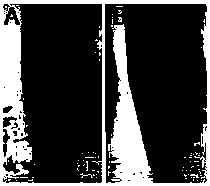A simple and ultrasensitive colorimetric detection method for divalent copper ions
A divalent copper ion and detection method technology, applied in the field of nano chemical sensing, can solve the problems of limited detection sensitivity, inability to use on-site analysis and instant inspection, cumbersome and time-consuming operation steps, etc., to reduce analysis cost and realize accurate quantitative detection , The effect of improving the detection sensitivity
- Summary
- Abstract
- Description
- Claims
- Application Information
AI Technical Summary
Problems solved by technology
Method used
Image
Examples
Embodiment 1
[0017] Individual detection of 20 μM Cu using a simple and ultrasensitive colorimetric detection method for divalent copper ions 2+ Sample solution and blank sample (ultrapure water).
[0018] Such as figure 1 As shown, the specific steps of this example are: Step 1, add 250 μL of 20 μM o-phenylenediamine solution (prepared from ultrapure water with a resistivity of 18.2 MΩ·cm) into a 1.5 mL plastic test tube , and then 250 μL of 20 μM Cu was added dropwise to the solution 2+ Sample solution (copper sulfate solution prepared by ultrapure water with a resistivity of 18.2 MΩ·cm), and shake the test tube to mix the two solutions evenly, then place it at 50°C for 60 minutes to react to prepare the reaction solution; step 2, in Continue to add 500 μL of red gold nanoparticle solution (with a particle size of about 13 nm, which is prepared by reducing chloroauric acid with sodium citrate) to the above reaction solution, and the surface of the prepared gold nanoparticles is negativ...
Embodiment 2
[0021] Analysis of Cu over the concentration range of 9.75 nM to 5 μM using a simple and ultrasensitive colorimetric detection method for divalent copper ions 2+ sample solution. The specific implementation process is as follows:
[0022] Such as figure 1 As shown, each Cu in this example 2+ The specific steps of sample solution analysis are as follows: step 1, add 250 μL of 20 μM o-phenylenediamine solution (prepared from ultrapure water with a resistivity of 18.2 MΩ cm) into a 1.5 mL plastic test tube, and then add 250 μL of a certain concentration of Cu was added dropwise to the solution 2+ Sample solution (copper sulfate solution prepared by ultrapure water with a resistivity of 18.2 MΩ·cm), and shake the test tube to mix the two solutions evenly, then place it at 50°C for 60 minutes to react to prepare the reaction solution; step 2, in Continue to add 500 μL of red gold nanoparticle solution (the particle size is about 13nm, which is obtained by reducing chloroauric a...
PUM
 Login to View More
Login to View More Abstract
Description
Claims
Application Information
 Login to View More
Login to View More - R&D
- Intellectual Property
- Life Sciences
- Materials
- Tech Scout
- Unparalleled Data Quality
- Higher Quality Content
- 60% Fewer Hallucinations
Browse by: Latest US Patents, China's latest patents, Technical Efficacy Thesaurus, Application Domain, Technology Topic, Popular Technical Reports.
© 2025 PatSnap. All rights reserved.Legal|Privacy policy|Modern Slavery Act Transparency Statement|Sitemap|About US| Contact US: help@patsnap.com



